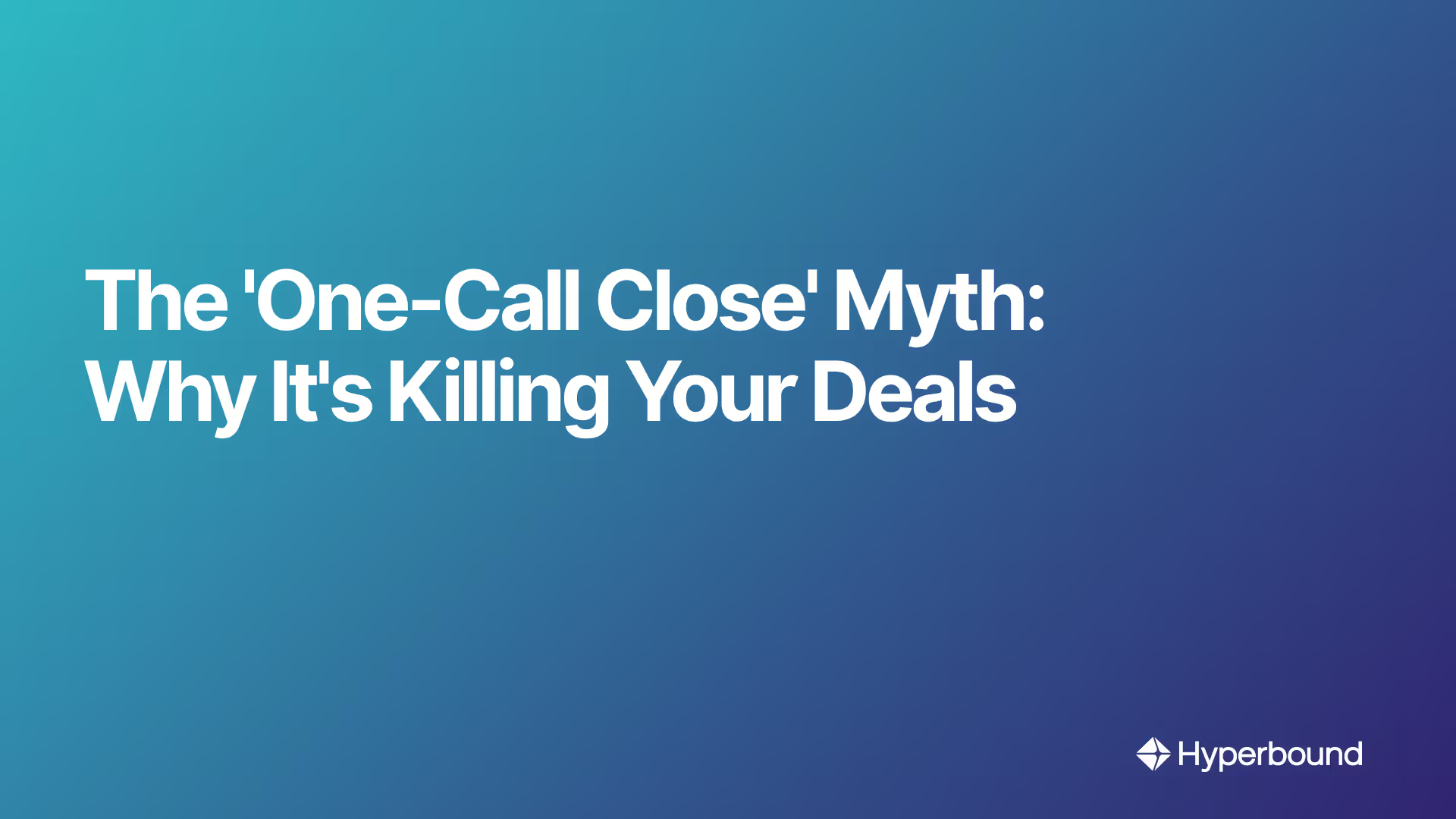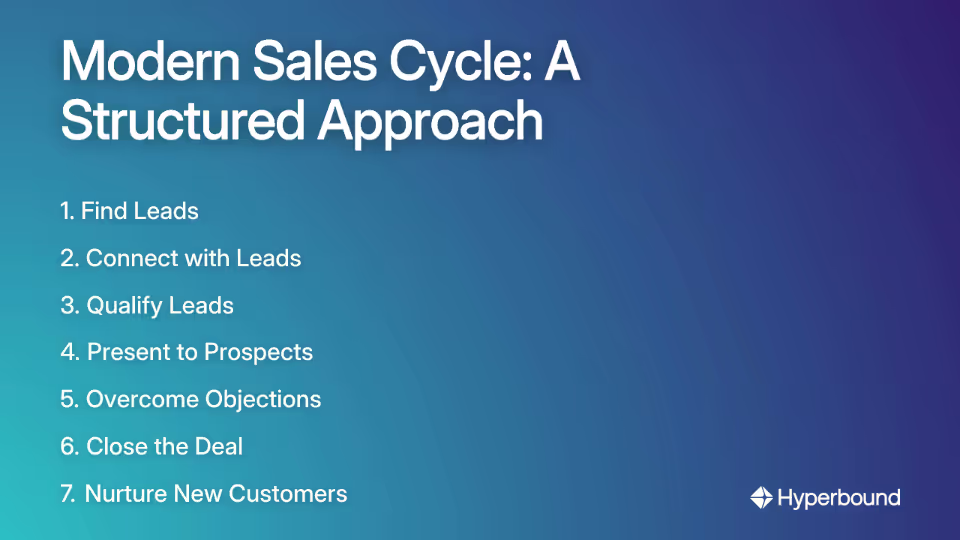
You've just wrapped up what felt like a great sales meeting. The rapport was solid, you understood their needs, and your solution seemed perfect. Then comes that moment—the push for the close. Suddenly, you can see it in their eyes—that flicker of distrust, that subtle pulling back. Your manager's voice echoes in your head: "Remember your one close mindset!" But something deep inside you knows this prospect needs more time.
Sound familiar? You're not alone.
"My manager pushes us to have what he calls a 'one close mindset'... it kills my mojo," confessed one sales rep on Reddit. "It feels very unnatural... I feel like I'm going against my natural style which was always just building relationships."
This obsession with closing on the first meeting is creating a generation of stressed sales professionals who feel their attempts to force a sale are actively eroding the very trust they need to succeed. As one rep put it, "I can sense they just lose my trust" the moment the hard sell begins.
This isn't just bad for morale; it's killing your deals.
In this article, we'll dismantle the one-call close myth by showing why it fails in today's market, explore its damaging effects on customer relationships and sales performance, and provide practical strategies for adopting a more effective approach. Most importantly, we'll arm you with tactics to manage leadership pressure and advocate for a sales cycle that truly fits your product and customer.
The Allure and Anatomy of the 'One-Call Close'
The one-call close is a sales strategy aimed at converting a lead into a customer within a single call or appointment. It demands precision and a deep, rapid understanding of the prospect's needs. For sales leaders, its appeal is obvious: efficiency, predictability, and the promise of a "winning culture."
According to the one close mindset playbook, the perfect close follows this framework:
- Thoroughly Qualify Prospects: Understanding needs, budget, and timeline
- Build Rapport Quickly: Establishing immediate trust
- Identify Key Pain Points: Using active listening
- Personalize Your Presentation: Tailoring the pitch to specific problems
- Demonstrate Solutions and Urgency: Showing how you can solve their problem now
- Overcome Objections: Being prepared with compelling counterarguments
- Complete the Sale: Confidently asking for commitment
This approach can work beautifully—in very specific circumstances. For simple, low-cost B2C sales with a single decision-maker and minimal research needed, the one-call close can be effective and appropriate.
But here's where the myth becomes dangerous: trying to apply this same pressure-cooker approach to complex B2B sales or high-value B2C transactions is like trying to force a square peg into a round hole. These sales typically involve multiple stakeholders, extensive research, and longer decision-making processes.
Forcing the one-call close in these scenarios doesn't just fail—it actively harms your chances of success.

Four Ways the 'One-Call Close' is Killing Your Deals
1. It Breeds Distrust and Creates a High-Pressure Atmosphere
The one-call close often creates a "fast-paced, uncomfortable atmosphere" that makes prospects feel rushed and pressured. This approach can lead to questionable ethics, such as creating false urgency by suggesting prices will rise if a contract isn't signed immediately.
As one sales representative candidly admitted: "I told him it's not about being a pussy, it's just logically even I would never ever sign for a service that expensive right away and I'd give it time." This powerful realization gets at the heart of the issue—if you wouldn't buy under these conditions, why would your prospect?
When prospects feel pressured, they don't just resist the current sale—they form a lasting negative impression that can damage future opportunities as well.
2. It Ignores the Complexity of Modern Buying Decisions
Today's prospects are highly informed and expect tailored interactions, not a "one-size-fits-all" pitch. They research solutions extensively before engaging with sales reps and often involve multiple stakeholders in their decision-making process.
Even for experienced sales professionals with high conviction, the data tells a compelling story. Sales coach Greg Faxon reports that 50% of his clients had more than one call before enrolling, proving that even for a successful coach, follow-up is essential, not a sign of failure.
The reality is that most significant buying decisions simply cannot be made in a single conversation, no matter how skillful the salesperson or how perfect the pitch.
3. It Causes Mistakes and Miscommunication
When operating under the pressure of a one-call close, the salesperson is forced to juggle too many tasks simultaneously: pitching, hearing ideas, selling products, building project models, and drafting contracts. This cognitive overload is a recipe for errors.
This rush leads to inaccuracies in proposals and ultimately buyer's remorse, which damages long-term relationships and brand reputation. A prospect who feels they were rushed into a decision is unlikely to become a loyal customer or refer others to your business.
4. It Destroys the Sales Rep's Conviction and Performance
Perhaps most damaging is the internal effect on sales reps themselves. Without genuine conviction in the approach, performance inevitably suffers. One rep confessed: "I have zero conviction that they should buy in the first meeting so that conviction can't be transferred."
This lack of confidence is immediately apparent to prospects. Customers can sense when you have what some call "commission breath"—that desperate energy that comes from focusing on your commission rather than their needs.
Another rep described the discomfort perfectly: "It feels like I'm a 7ft power forward... and now I've been moved into becoming a shooting guard." This analogy captures the pain of being forced into a sales style that simply doesn't fit your natural strengths.

The Solution: Embracing a Modern, Multi-Touch Sales Cycle
Instead of the high-pressure one-call close, successful modern selling requires embracing a structured sales cycle—a repeatable, tactical process that provides structure and predictability while respecting the prospect's decision-making process.
A well-designed sales cycle typically includes these stages:

- Find Leads
- Connect with Leads
- Qualify Leads
- Present to Prospects
- Overcome Objections
- Close the Deal
- Nurture New Customers
Notice that "Closing" is just one step in a longer journey, not the entire race. This framework acknowledges the reality that building relationships takes time and that most significant purchases require multiple touchpoints.
Strategy 1: Shift from High-Pressure Closing to Low-Pressure Consulting
Adopt an educator's mindset. Focus on helping the prospect make an informed decision rather than pushing them toward an immediate purchase. This builds trust and positions you as an advisor rather than just another salesperson.
In home remodeling, for example, successful companies have moved to a low-pressure selling model: an initial, shorter consultation to assess fit, followed by a dedicated proposal presentation later. Companies like JSB Home Solutions take an average of 8 days between these steps to ensure accuracy and give customers breathing room.
This approach may seem less efficient on paper, but it results in higher conversion rates, larger deal sizes, and significantly better customer satisfaction.
Strategy 2: Master the Art of the Intentional Follow-Up
The goal of an initial call isn't always to close; often, it's to secure the next call. By reframing success metrics around advancing the prospect through your sales cycle rather than immediate closing, you relieve pressure while maintaining momentum.
When a prospect says, "I need to think it over," respond with curiosity, not pressure: "What specifically do you want to think about?" This uncovers the real objection and keeps the conversation going.
Mastering this conversational pivot requires practice. AI sales role-play tools allow reps to simulate these exact scenarios, turning tough objections into opportunities to build trust rather than dead ends.
If they're genuinely indecisive, keep the momentum by scheduling a follow-up call within 24 hours. Assign "homework" to keep them engaged, such as reviewing a case study, writing down their remaining questions, or even engaging with helpful content like relevant resources or tools.
Using social proof strategically in follow-up communications can also be powerful. Sharing case studies or testimonials that specifically address the concerns or objectives your prospect expressed shows that you're listening and that others with similar circumstances have benefited from your solution.
Managing Up: How to Get Leadership to Abandon the Myth
"I feel like if I just stuck to my old style and just gave them time to think it would work, but I have this anxiety of my manager being an asshole."
This candid confession from a sales rep captures the pressure many feel. Here's how to manage it:
Step 1: Understand Where the Pressure Comes From
Your manager faces their own pressures: aggressive revenue targets, team management duties, and market volatility. This isn't an excuse for creating a toxic environment, but understanding their "why" is key to having a productive conversation.
Step 2: Argue with Data, Not Feelings
Managers respond to numbers, not complaints. Track your own metrics: what is your close rate on one-call attempts versus deals that take 2-3 calls? Use your CRM to document the average sales cycle length and conversion rates between stages. Platforms that provide AI real call scoring can bolster this case by automatically analyzing calls and providing hard data on which approach leads to better outcomes.
Leverage external data: "Research shows that a significant percentage of deals, as high as 50% in some cases, require more than one conversation to close." This helps demonstrate that your approach isn't about avoiding closing—it's about closing more effectively.
Step 3: Propose a Pilot Program
Don't just challenge the status quo; come with a solution. Ask to run a test on a small segment of leads using a structured, multi-touch sales cycle. Frame it as a strategy to increase long-term revenue and customer lifetime value, not as an attempt to be "passive" or avoid closing.
Present a clear framework with specific metrics you'll track to demonstrate the effectiveness of your approach. This shows you're serious about results, just approaching them differently.
From High-Pressure Tactics to High-Trust Partnerships
The "one-call close" is an outdated relic from a different era of sales. In a world of informed buyers and complex solutions, it has become a liability that damages trust, morale, and ultimately, your bottom line.
The future of successful selling lies in a consultative, multi-touch approach that respects the prospect's decision-making process. By embracing a structured sales cycle, focusing on education rather than pressure, and mastering the art of the follow-up, you shift from being just another vendor to becoming a trusted partner who can command respect and secure larger, more sustainable deals.
Future pacing is essential here—help both your prospects and your leadership see the long-term benefits of a relationship-based approach. The sale you don't rush today may become the loyal customer who refers five new clients next year.
True sales mastery isn't about the speed of the close; it's about the strength of the relationship you build along the way. That is what leads to sustainable success and a career you can be proud of—without the dreaded "commission breath."

Frequently Asked Questions About the One-Call Close
What is a one-call close in sales?
A one-call close is a sales strategy where the goal is to convert a new lead into a paying customer within a single meeting or phone call. This approach emphasizes efficiency and speed, requiring the salesperson to quickly build rapport, identify pain points, present a solution, handle all objections, and secure a commitment in one interaction. While appealing for its speed, it is often only suitable for simple, low-cost products with a single decision-maker.
Why is the one-call close mindset often harmful for sales?
The one-call close mindset is harmful because it often creates a high-pressure environment that erodes customer trust, ignores the complexity of modern buying decisions, and can lead to sales rep burnout. Forcing a quick decision on complex or high-value sales can make prospects feel rushed and disrespected, leading them to resist the sale and form a negative impression of your company. It also puts immense stress on reps, forcing them into an unnatural sales style that undermines their conviction and performance.
When is a one-call close actually effective?
A one-call close can be effective in specific situations, typically for low-cost, low-risk B2C products or services where the decision-making process is simple and involves only one person. Think of transactional sales like signing up for a simple subscription service or buying a standard consumer good. In these cases, the customer has often done their research, the value proposition is clear, and a lengthy sales cycle is unnecessary. The danger lies in applying this tactic to complex B2B sales with multiple stakeholders and longer consideration periods.
What is a better alternative to the one-call close?
A better alternative is a modern, multi-touch sales cycle that focuses on building a relationship and guiding the prospect through their decision-making process over several interactions. This approach, often called consultative selling, positions the salesperson as a trusted advisor rather than a high-pressure closer. It involves multiple stages, from initial connection and qualification to presentation, objection handling, and closing, all done at a pace that respects the buyer's journey.
How can I handle pressure from my manager to close deals on the first call?
Handle pressure from your manager by using data, not just feelings, to argue for a more flexible sales process. Propose a pilot program to test a multi-touch approach on a segment of leads. Track your own metrics, such as the close rates for one-call attempts versus multi-call deals. Present this data to your manager to show that a longer cycle can lead to higher conversion rates and better customer relationships. Framing your suggestion as a data-driven experiment to increase revenue is more effective than simply complaining about pressure.
How do I respond when a prospect says they need more time to decide?
When a prospect needs more time, respond with curiosity instead of pressure. Ask clarifying questions to understand their specific concerns and then schedule a clear next step. Instead of pushing back, say something like, "That makes sense. What specifically would you like to think about?" This helps uncover the real objection. The goal of the first call then shifts from closing the deal to securing an intentional follow-up meeting. You can also assign "homework," like reviewing a case study, to keep them engaged between calls.
What are the key stages of a modern sales cycle?
A modern, multi-touch sales cycle typically includes seven key stages: finding leads, connecting, qualifying, presenting, overcoming objections, closing the deal, and nurturing new customers. This structured process acknowledges that closing is just one part of a larger journey. By breaking the process down, sales teams can create a predictable and repeatable system that builds trust and momentum at each step, leading to more sustainable success than a high-pressure, single-call approach.
Book a demo with Hyperbound
.png)













